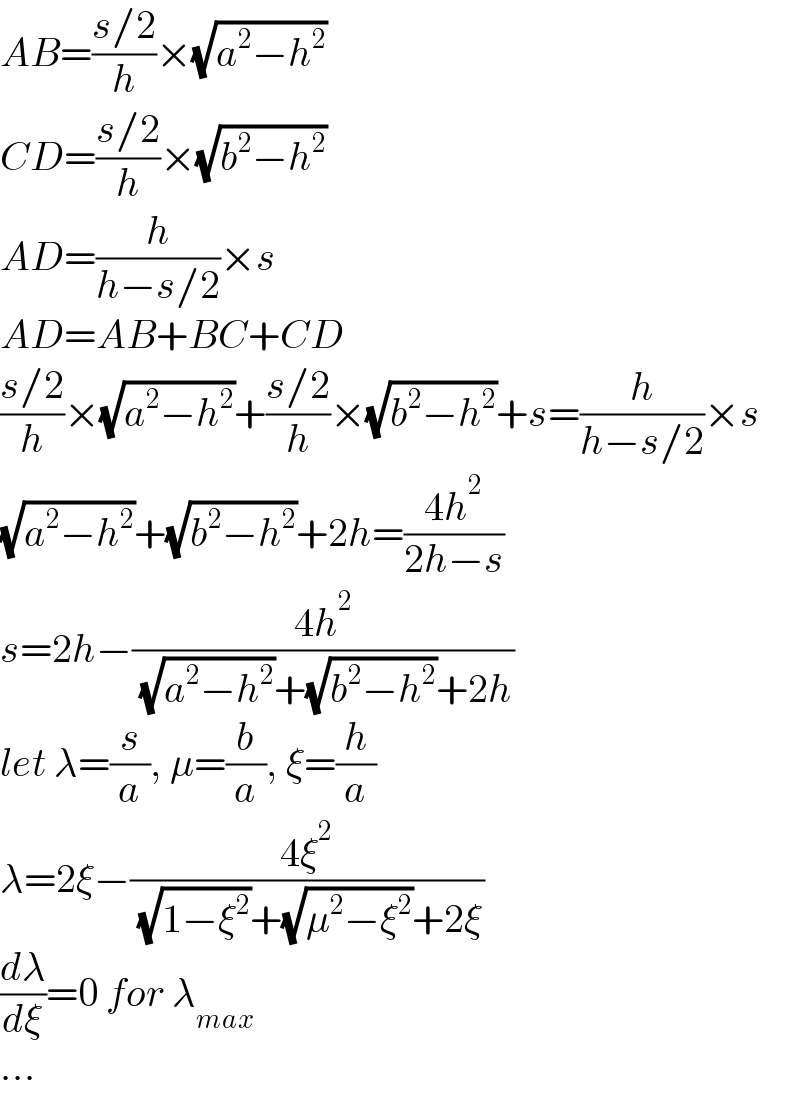Question Number 158622 by ajfour last updated on 06/Nov/21

Commented by ajfour last updated on 06/Nov/21

$${Find}\:{maximum}\:{side}\:{length} \\ $$$${of}\:{inscribed}\:{square}\:\left({s}_{{max}} \right). \\ $$
Answered by mr W last updated on 07/Nov/21

Commented by mr W last updated on 07/Nov/21

$${AB}=\frac{{s}/\mathrm{2}}{{h}}×\sqrt{{a}^{\mathrm{2}} −{h}^{\mathrm{2}} } \\ $$$${CD}=\frac{{s}/\mathrm{2}}{{h}}×\sqrt{{b}^{\mathrm{2}} −{h}^{\mathrm{2}} } \\ $$$${AD}=\frac{{h}}{{h}−{s}/\mathrm{2}}×{s} \\ $$$${AD}={AB}+{BC}+{CD} \\ $$$$\frac{{s}/\mathrm{2}}{{h}}×\sqrt{{a}^{\mathrm{2}} −{h}^{\mathrm{2}} }+\frac{{s}/\mathrm{2}}{{h}}×\sqrt{{b}^{\mathrm{2}} −{h}^{\mathrm{2}} }+{s}=\frac{{h}}{{h}−{s}/\mathrm{2}}×{s} \\ $$$$\sqrt{{a}^{\mathrm{2}} −{h}^{\mathrm{2}} }+\sqrt{{b}^{\mathrm{2}} −{h}^{\mathrm{2}} }+\mathrm{2}{h}=\frac{\mathrm{4}{h}^{\mathrm{2}} }{\mathrm{2}{h}−{s}} \\ $$$${s}=\mathrm{2}{h}−\frac{\mathrm{4}{h}^{\mathrm{2}} }{\:\sqrt{{a}^{\mathrm{2}} −{h}^{\mathrm{2}} }+\sqrt{{b}^{\mathrm{2}} −{h}^{\mathrm{2}} }+\mathrm{2}{h}} \\ $$$${let}\:\lambda=\frac{{s}}{{a}},\:\mu=\frac{{b}}{{a}},\:\xi=\frac{{h}}{{a}} \\ $$$$\lambda=\mathrm{2}\xi−\frac{\mathrm{4}\xi^{\mathrm{2}} }{\:\sqrt{\mathrm{1}−\xi^{\mathrm{2}} }+\sqrt{\mu^{\mathrm{2}} −\xi^{\mathrm{2}} }+\mathrm{2}\xi} \\ $$$$\frac{{d}\lambda}{{d}\xi}=\mathrm{0}\:{for}\:\lambda_{{max}} \\ $$$$… \\ $$
Commented by mr W last updated on 07/Nov/21

Commented by ajfour last updated on 07/Nov/21

$$\mathbb{T}\mathrm{hank}\:\mathrm{you}\:\mathrm{sir}.\:\mathrm{I}'\mathrm{ll}\:\mathrm{think}\:\mathrm{of} \\ $$$$\mathrm{some}\:\mathrm{better}\:\mathrm{elliptic}\:\mathrm{way}. \\ $$
Commented by ajfour last updated on 07/Nov/21

$${s}^{\mathrm{2}} ={h}\sqrt{{a}^{\mathrm{2}} −{h}^{\mathrm{2}} }+{h}\sqrt{{b}^{\mathrm{2}} −{h}^{\mathrm{2}} } \\ $$$$\:\:\:\:\:\:\:\:\:\:−\left\{\frac{{s}}{\mathrm{2}}{p}+\frac{{s}}{\mathrm{2}}{q}+{s}\left({h}−\frac{{s}}{\mathrm{2}}\right)\right\} \\ $$$${p}+{q}+{s}=\sqrt{{a}^{\mathrm{2}} −{h}^{\mathrm{2}} }+\sqrt{{b}^{\mathrm{2}} −{h}^{\mathrm{2}} } \\ $$$$\Rightarrow\:\:{hs}=\left({h}+\frac{{s}}{\mathrm{2}}\right)\left(\sqrt{{a}^{\mathrm{2}} −{h}^{\mathrm{2}} }+\sqrt{{b}^{\mathrm{2}} −{h}^{\mathrm{2}} }\right) \\ $$$$\Rightarrow \\ $$$$\:\frac{\mathrm{1}}{\boldsymbol{{s}}}=\frac{\mathrm{1}}{\:\sqrt{\boldsymbol{{a}}^{\mathrm{2}} −\boldsymbol{{h}}^{\mathrm{2}} }+\sqrt{\boldsymbol{{b}}^{\mathrm{2}} −\boldsymbol{{h}}^{\mathrm{2}} }}−\frac{\mathrm{1}}{\mathrm{2}\boldsymbol{{h}}} \\ $$$$\:\:\:\:\:\:\:\:\:\:\:\:\:\:\:\:\:\:\:…………… \\ $$
Commented by Tawa11 last updated on 07/Nov/21

$$\mathrm{Great}\:\mathrm{sir} \\ $$
